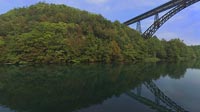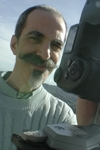
Iron bridge over Adda river, for cars (on the top) and trains (one crossing)
Between Paderno d'Adda and Calusco d'Adda, Adda's river, almost 40 Km NE of Milan, Italy
19 september 2004, at 16,30 UTC
The bridge was built more then one century ago, in the years 1887-1889, and it excited admiration all around Europe.
It was mentioned in many engineering texts, where it was ranked in the major arch-bridges in the world, such as those on Mississipi, on Douro, on Truyere, on Schwarzwasser.
Other famous railway bridges are contemporary, or even older, such as Conway and Windsor in England (almost 300 years on the whole) or Saltash and Longou in France (130 years old each one).
It is really one of the most famous iron monuments of the nineteenth century (even compared to the Eiffel Tour) thanks to its elegant proportions, projects accuracy and construction perfection.
You can feel those old emotions even now, when you walk on it and, when stopping in the centre, you can enjoy of the same views which inspired Leonardo da Vinci for this backgrounds (for instance in the Virgin of the Rocks).
Try to imagine how many different means of transportation passed through the bridge during the last century: horses, carts, carriages, the first motor-cars and the modern convertibles, steam trains and electronic locomotives.
At the end of the nineteenth century the historic scenario shows a quite poor situation in railway transportation in Italy: a total lack in Sicily and Sardinia, some single lines somewhere else, like the one near Milan (which was completed with other regional links only twenty years later).
In this regard the crossing of Adda river (the fourth river in Italy) was an important step.
Many firms took part in the competition, and the winner was "Officine di Savigliano" with a construction plan of 18 months.
The designer was a Swiss engineer, Giulio Rothlisberger, who was head of the technical department of "Officine of Savigliano" and had already planned other bridges in Europe.
There is a legend about his death: someone says that he committed suicide at the eve of the testing by throwing himself into the river because he was worried about the swinging of the bridge and its possible collapse. On the contrary, as matter of fact, he attended the inauguration ceremony and died of pneumonia twenty years later.
As far as the construction itself, the first step was the realization (in 11 months) of a service wooden bridge, employing 2,000 cubic meters of wood coming from upper Bavaria. Meanwhile, the foundation works for the piers began, and all necessary materials were transported by river on cargo boats.
The arch was completed in February 1889, employing 100,000 rivets: 470 workers took part in the construction, and some of them died during the realization. The bridge was finished in March 1889 and the painting of the same was completed in summer 1890.
The testing was in May 1889, when a train composed by 3 locomotives and 30 wagons crossed the bridge at a speed from 25 to 40 Km per hour (wow!).
At that time, San Michele bridge was the first one in Italy with an arch of 150 meters. The total length is 266 meters, the road track is 5 meters large, the highness is 82 meters and it weighs 5.650 tons.
A second testing took place in 1892, and after II World War, the spans were strengthened and other reinforcements were completed in 1950.
Presently, San Michele bridge is over one hundred years old, some projects for a new bridge have been considered but never accomplished.
This imposing bridge, as a symbol of Italian industrial archaeology and an interesting engineering work of the nineteenth century, was included in Unesco heritage.
Notwithstanding its age, the old bridge remains a charming sight, particularly at night when you can admire the iron embroideries enlighted by lamps placed on both banks of Adda.



 Tap or click the zoom icon in the bottom right corner of the picture to switch between in-page and fullscreen view
Tap or click the zoom icon in the bottom right corner of the picture to switch between in-page and fullscreen view